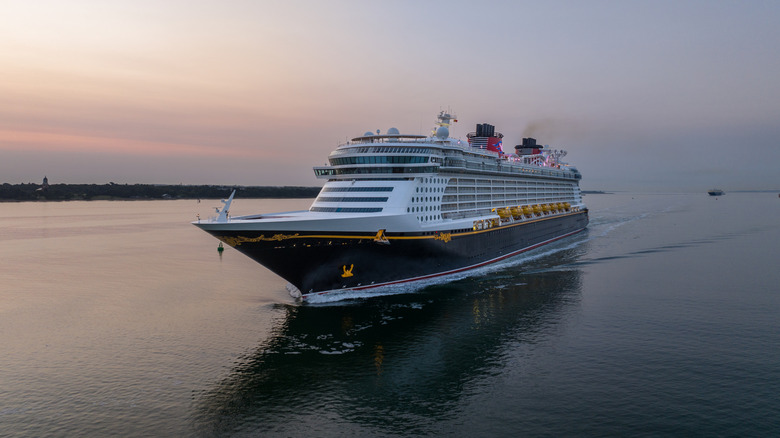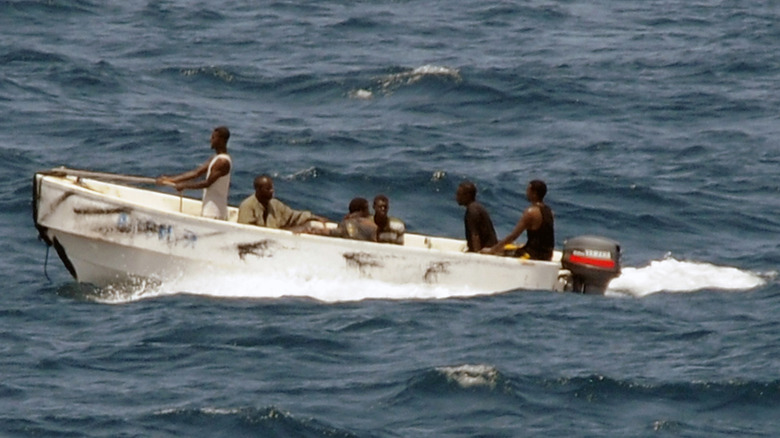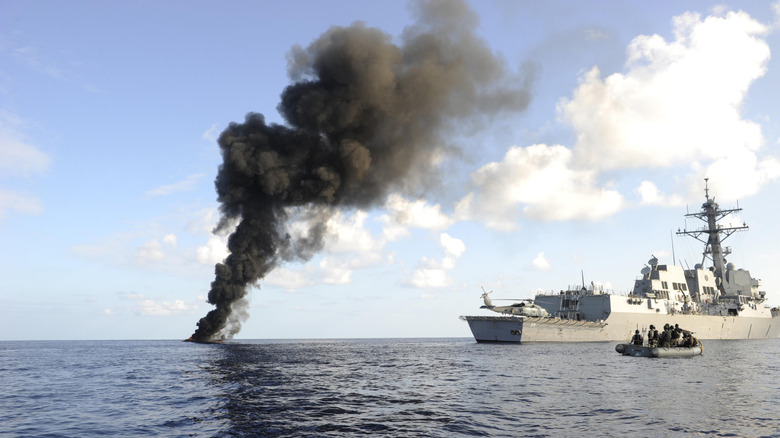What Really Happens If Pirates Try To Board Your Cruise Ship
When you hear the word "pirate," you're likely thinking of dashing Johnny Depp, decked out in his Captain Jack Sparrow getup topped with the iconic tricorne hat. You might imagine a thrilling life of adventuring around Caribbean islands, where a bevy of swashbuckling buccaneers climb aboard an 18th-century battleship in search of treasure. However, the reality of piracy, despite its romantic depictions on the silver screen, is much darker (think more Abduwali Muse in "Captain Phillips" and less Jack Sparrow). In the place of charming Casanovas engaged in swordplay and witty banter are violent men armed with guns, RPGs, and missiles. Attacks are mostly confined to specific areas well-known for piracy, including the Somalian coastline, the Malacca Strait, and the Gulf of Aden, and to particular kinds of vessels — primarily lucrative oil tankers and cargo ships. But although cruises are generally very safe and do not experience frequent attacks, they're still not immune from the occasional pirate interaction.
One of the most famous attacks occurred in April of 2009, around 180 miles north of the Seychelles, against a vessel owned by the Italian MSC Cruises. Six pirates approached the 1,500-person MSC Melody at night in a speedboat, opened fire, and tried to board. However, they were thwarted by the efforts of those on the ship: The crew sprayed them with water, the security team fired warning shots, and passengers even threw deck chairs overboard in an attempt to knock them down. After five minutes, the group abandoned their mission. Certainly, a pirate attack would be one of the worst things to ever happen on a cruise ship — but thankfully, they're exceedingly rare (just a handful of incidents over the last two decades). The odds of you getting food poisoning or a hangover are much higher than being attacked by pirates!
What piracy is and how it impacts cruising
An act of piracy is defined by the United Nations Convention on the Law of the Sea as "any illegal acts of violence or detention, or any act of depredation, committed for private ends ... on the high seas, against another ship," and a pirate is someone who engages in said activities. They are different from terrorists in that their motivation is typically financial, rather than political or religious. However, this doesn't make them any less dangerous. Modern pirates, similar to those in the days of yore, do what they do as a result of high levels of poverty and a lack of economic opportunities, meaning that they're often angry and desperate.
Despite the risks, attacks on cruise ships are extremely uncommon — you're more likely to experience crime, such as petty theft, at some of the most dangerous cruise ports or find yourself in a tropical storm (if you try to save money by embarking on a Caribbean cruise during hurricane season). This is because most cruise ships avoid high-risk areas, are equipped with excellent detection technology, and aren't worthwhile targets. While a team of well-organized pirates could certainly hold the crew of a cargo ship hostage, it would be much more difficult to control thousands of crew and passengers on a ship the size of a small city.
And if the worst-case scenario came to pass, staff are actually trained in what to do. The specific security protocols for each cruise liner are not advertised publicly in order to prevent criminals from becoming aware of them as well. But rest assured, crews on every ship are prepared to handle a variety of emergencies, including pirate attacks, and they constantly monitor their surroundings, looking out for any suspicious activity on the ocean.
What cruise ships, staff, and you can do during a pirate attack
Cruise ships are equipped with a variety of tools to protect passengers, such as surveillance cameras, spotlights, sonar, radar, and other vessel-tracking equipment. They possess several non-lethal deterrents, too, like water cannons. These can unleash a spray of seawater at 5,110 liters per minute at a pressure of 175 PSI (pound-force per square inch) — powerful enough to easily repel an approaching vessel or completely flood it. Many also have LRADs (Long Range Acoustic Devices) on board, which emit a high-frequency noise loud enough to induce nausea and hearing impairment for those in the path of its sonic waves. Another available measure is the P-Trap — an anti-piracy system that consists of a set of thin lines, dragged through the water by strong metal rods, which will prevent a vessel from nearing the ship. Note that cruise ships don't usually carry firearms as they are illegal at most ports of call and can escalate dangerous situations quickly.
Additionally, there are some evasive maneuvers that ships can employ, including creating waves to capsize attackers' boats, zigzagging to avoid contact, and speeding ahead. Cruiseliners can sail much faster than your average pirate's rundown fishing vessel, making them a challenging target to catch. Finally, there are things that you can do as an individual to keep safe. Listen and follow the instructions of the crew, who are there for your security and have been trained for this ordeal. Don't try to be a hero — you're not John McClane, and your actions could put others at risk. As well, all cruise ship passengers should get one important thing: travel insurance. While piracy itself isn't typically covered by most policies, the associated risks, like trip interruption and cancellation, emergency evacuations, and medical costs, will be.


